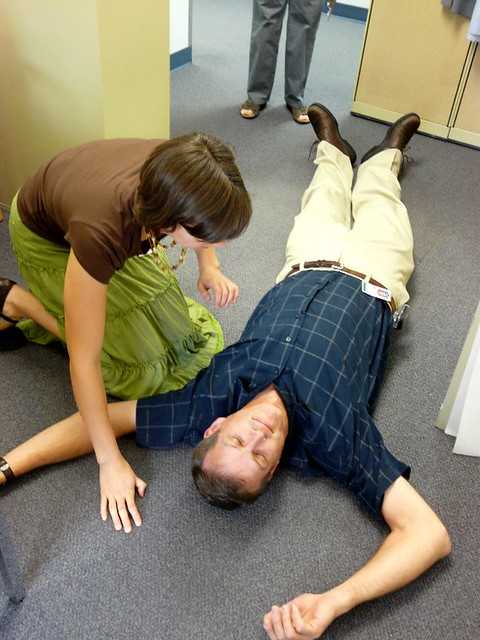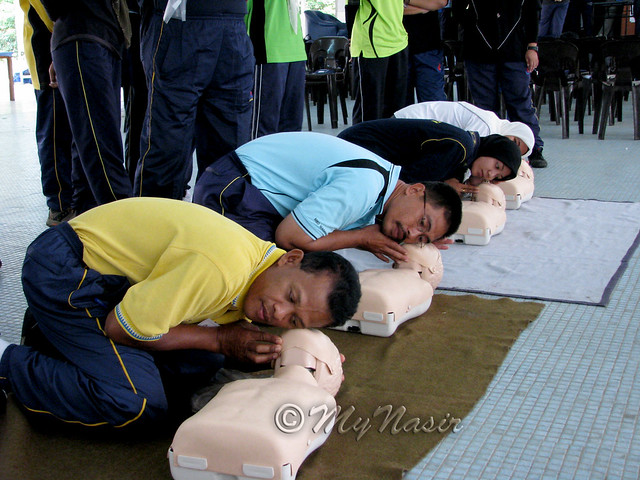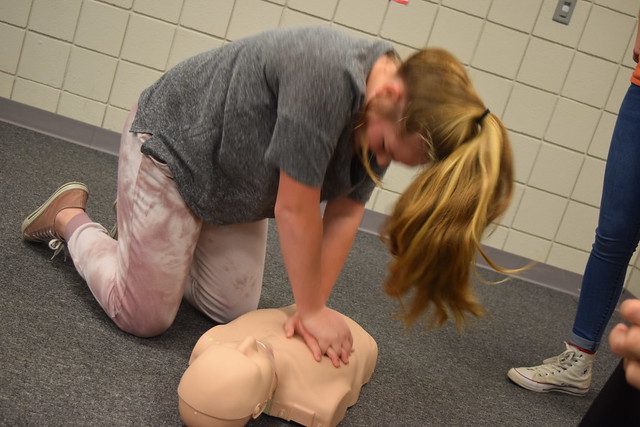Cardiopulmonary resuscitation
(CPR) is a lifesaving technique useful in many emergencies, including a heart
attack or near drowning, in which someone's breathing or heartbeat has stopped.
Since heart attack is sudden, and a patient can die within a seconds, then CPR
technique matter. It is important for all of us to learn how to perform CPR,
because we can serve many lives of our family members and neighbors.
CPR technique is not treatment for
heart attack, it is first aid for helping patients with heart attack the moment
they are waiting for medical assistance. The disadvantage of this technique is
that you can't do on yourself, take a look for someone who is alone and
suddenly heart attack occurs, how could such person serve himself/herself?...it
is so terrible, such person can die by lacking medical assistance. Luckily
there is another method that patients with heart attack can serve themselves
when they're alone, the moment they are waiting for medical help or personal
assistance. To learn such method CLICK HERE.
Also CPR steps will help to
restore blood circulation and oxygen in the body. Early use of an AED, if one
is available, can restart a heart with an abnormal rhythm. AED stands for
'automated external defibrillator'
* An automated external
defibrillator (AED) is a lightweight, portable device that delivers an electric
shock through the chest to the heart. The shock can potentially stop an
irregular heartbeat (arrhythmia) and allow a normal rhythm to resume following
sudden cardiac arrest (SCA).
Photo: AED
STEPS FOR PERFORMING CPR
Doing CPR can increase a person’s chance of surviving cardiac
arrest. Learn these CPR steps you will now know what to do if someone is
experiencing a life threatening emergency. Before starting CPR open a person’s airway to check if they are
breathing (don’t
begin CPR if a patient is breathing normally). Then, get help. If you are not
alone, send someone to call for help as soon as you have checked breathing and
have the person confirm the call has been made. While help is on the way,
follow these steps to perform CPR.
Step 1: Check for the environment
around whether it is safe or not, always check for danger and look for risks
before you start helping.
Step 2: Check whether a person is
conscious or unconscious, by shaking his shoulders and shouting to him loudly “Are you alright?" If the
person doesn't respond he is unconscious.
Robin tries to "save" Eldon flickr photo by American Red Cross Cascades Region shared under a Creative Commons (BY-NC) license
Step 3: Check for normal breathing
A person with heart attack or
cardiac arest does not breathe or don't breathe normally and not conscious.
Check for normal breathing by looking for the following;
- Listening for breathing
- Check for regular chest
movements
- Feeling for breath on your
cheek.
*Cheek is the soft skin on each
side of the face, below the eyes; the outer surface of the sides of the oral
cavity.
CPR 2 flickr photo by MyNasir shared under a Creative Commons (BY) license
NB:
Make sure the time for checking
normal breathing do not exceed 10 seconds. Don’t confuse gasps with normal breathing. If you are not sure
if their breathing is normal, act as if it's not normal.
If you are sure the person is
breathing normally, take him to the nearest hospital immediately.
If the person is not breathing at all, then call a medical
help or an ambulance before starting CPR.
Step 4: If a person is not
breathing, then call for an ambulance or medical help before starting CPR
Step 5: Give 30 chest compressions
Kneel next to the person, then place
the heel of one hand in the centre of their chest. Place your other hand on top
of the first. Interlock your fingers. With straight arms, use the heel of your
hand to push the breastbone down firmly and smoothly, so that the chest is
pressed down between 5 - 6 cm, and release.
Do this at a rate of 100 to 120
chest compressions per minute (approximately about 2 chest compressions per
second)
CPR 006 flickr photo by clooney_97 shared under a Creative Commons (BY-SA) license
Step 6: Give two rescue breaths
Open the airway again by tilting
the head back and lifting the chin. Pinch the soft part of the person’s nose closed. Take a normal
breath, make a seal around their mouth and breathe out steadily.
The person’s chest should rise and fall.
Keeping the person’s
head back and the chin lifted, take your mouth away, take another normal
breath, and give a second rescue breath. The two breaths should take no longer
than five seconds.
Step 7: Repeat until an ambulance
arrives
Repeat 30 compressions and two
rescue breaths (Place your hands on the chest again and repeat the cycle of 30
chest compressions, followed by two rescue breaths. Continue the cycle.)
love korean style flickr photo by istolethetv shared under a Creative Commons (BY) license
Photo: Rescue breaths
If you didn't give rescue breaths
then call medical help and deliver hands-only CPR. That’s better than doing nothing. The
American Heart Association uses the letters C-A-B (compressions >>
airway >> breathing) to help people remember the order to perform the
steps of CPR.
Continue on doing CPR until
professional help arrives and takes over, or the person starts to show signs of
regaining consciousness, such as coughing, opening their eyes, speaking, or
breathing normally.
If you are feeling tired, and
there’s someone nearby to
help, instruct them to continue until medical help or an ambulance arrives.
NB:
The American Heart Association
(AHA) recommends Hands-Only CPR (CPR without rescue breaths) for people
suffering out-of-hospital cardiac arrest. According to the AHA, only about 39 percent
of people who experience an out-of-hospital cardiac arrest get immediate help
before professional help arrives; doing Hands-Only CPR may be more comfortable
than doing rescue breaths for some bystanders and make it more likely that they
take action. The AHA still recommends CPR with compressions and breaths for
infants and children and victims of drowning, drug overdose, or people who
collapse due to breathing problems.
If you have any opinions about this article feel free to
leave your thoughts on the comments section below. Don't miss our future post,
See you next time!.
Posted by: Lusubilo A. Mwaijengo







Post a Comment